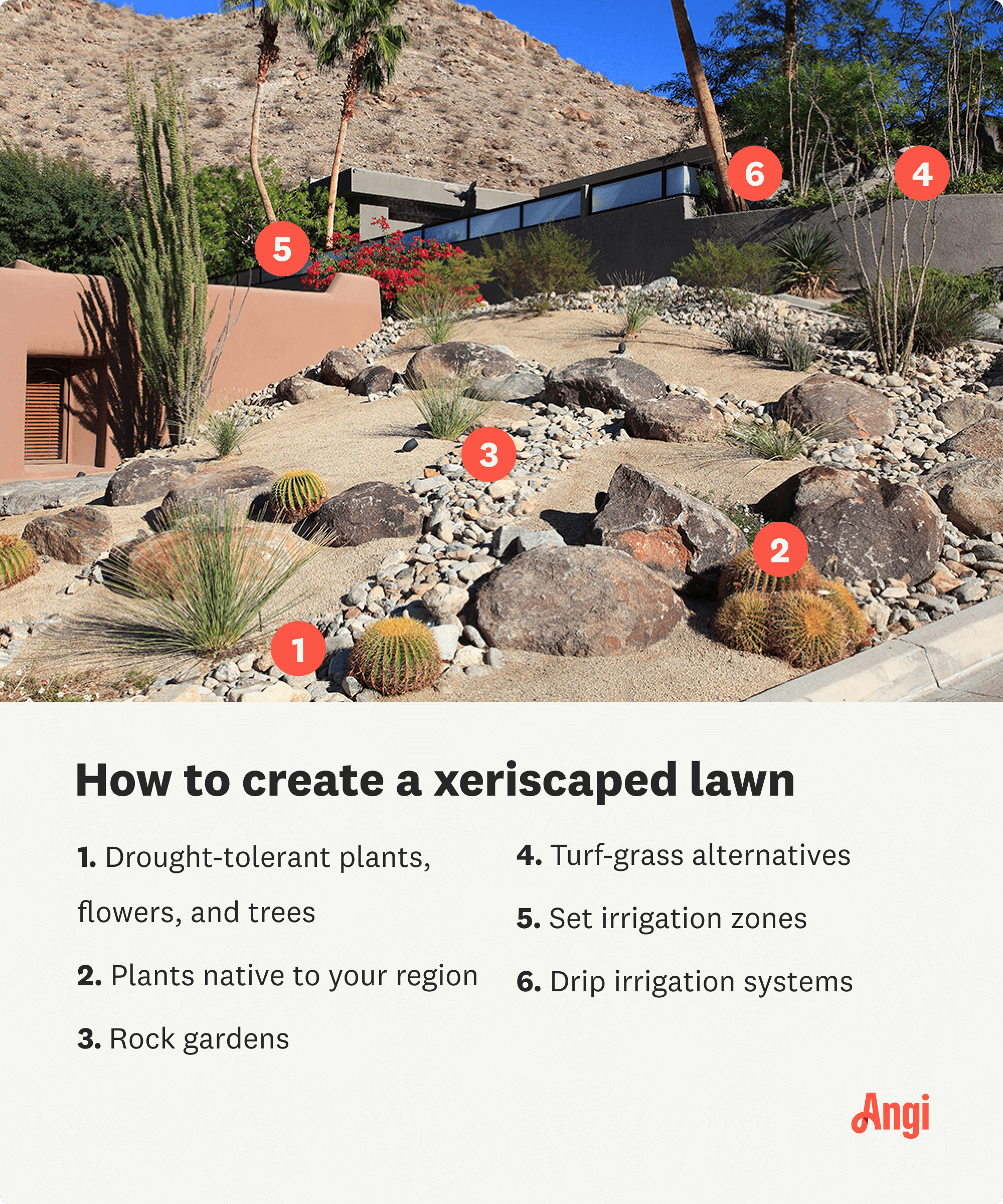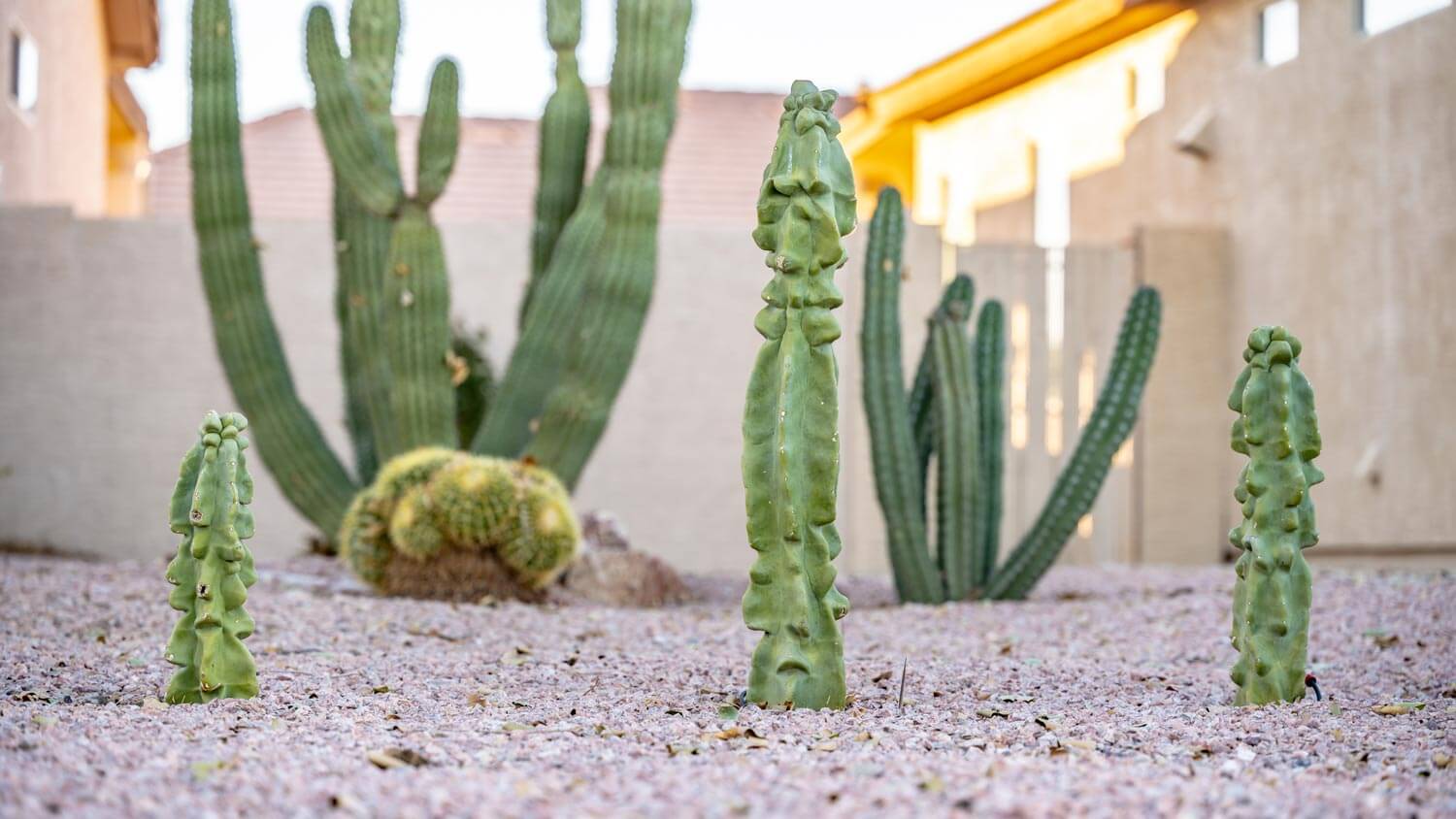What Is Xeriscaping, and How Can You Do It Successfully?
A xeriscaped yard can help alleviate landscaping stress


Xeriscaping is a form of landscape design that requires minimal water.
The process uses drought-tolerant and native plants.
Ground cover plants, rocks, and mulch replace traditional turfgrass.
Low-flow and drip irrigation are often all that is required to keep the yard healthy.
As an avid gardener and lawn lover, you are likely considering how to make your home’s landscaping as low-maintenance as possible and better for the environment at the same time. You may have heard the term “xeriscaping.” This is a popular type of landscaping that reduces water usage by combining vibrant local plants and clever irrigation tricks to adapt to drought-prone climates. Adopting this mindful form of gardening and lawn care can help save money, time, and, above all else, conserve water around the house.
What Is Xeriscaping?
Xeriscaping is landscaping that uses drought-tolerant plants and flowers that are typically local to a region and ready to adapt to the climate. In theory, xeriscape plants should be able to live almost entirely off of local precipitation. Xeriscaping also incorporates irrigation systems that work with gravity, such as rock gardens, consolidated irrigation zones, or low-flow irrigation. Xeriscaping does tend to cut back on common lawn features like turfgrass and nonnative flowers or veggies, but it still features plenty of color, lush greenery, and pollinator favorites.
There is a common misconception that xeriscaping—and conservation techniques, in general—only include cutting back or paring things down. In fact, a lot of gardeners mix up the word xeriscaping for "zeroscaping," with the attached assumption that you must have a bare, rocky lawn without any plant life.
The word “xeriscape” actually comes from “xiros,” the Greek word for dry. According to National Geographic, the process can cut down on water usage by 50% to 75% per home each year.
How Much Does Xeriscaping Cost?
You may be getting excited about this new yard idea, but how much does xeriscaping cost? Generally, you can expect to spend anywhere from $3,000 to $24,000. You can expect to pay the lower end of the price range for smaller patios, while a full-blown backyard project can reach $24,000. The biggest cost factors are the materials you choose, the irrigation system installation, and the cost of a xeriscape design.
Keep in mind that you may need to plan for additional costs to prepare your property, which can require excavation, tree removal, and boulder removal.
Xeriscaping vs. Traditional Lawns
Many people’s dream yards tend to feature a lush, green lawn. After all, it is one of the most common and traditional options for a yard. But did you know that lawn grasses are not native to the United States? In fact, many grasses planted here are native to Europe. That is why lawns require so much maintenance and upkeep with fertilizers, herbicides, and insecticides to keep them green and healthy.
When you opt for xeriscaping, you are making the switch to native plants. That is why there are so many benefits. Since the plants naturally grow in your area and climate, it requires less work and money to maintain.
Benefits of Xeriscaping
While doing your part for the environment is more than enough to make the switch, xeriscaping has many benefits that affect your utility bills, home value, and general outdoor enjoyment. With a bit of planning, you can create a breathtaking lawn that blends almost seamlessly with your surrounding landscape.
The top benefits of xeriscaping include:
Less water usage
Reduced water runoff
Lower water bills
Bright and beautiful landscapes
Less time for mowing and maintenance
Attracting pollinators
Drought-, pest-, and disease-tolerant plants
Possible regional tax incentives for approved xeriscaping methods
Types of Xeriscaping Plants
Xeriscaping plants require little water. However, since drought tolerance depends on your geographic region and USDA hardiness zone, spend some time researching which plants will work best for your climate. Some prime examples of drought-tolerant plants include the following:
| Plant | Hardiness Zones |
|---|---|
| Christmas ferns | 1–3 |
| Switchgrass | 3–9 |
| Broomsedge | 5–10 |
| Goldenrod | 2–8 |
| Wild indigo | 3–9 |
| Butterfly weed | 3–9 |
| Trumpet honeysuckle | 4–9 |
| Catmint | 3–8 |
| Lavender | 5–9 |
| Rosemary | 6–9 |
| Cacti | 4–9 |
| Marigold | 2–11 |
| Zinnia | 2–11 |
| Creeping thyme | 4–9 |
| Creeping Phlox | 3–9 |
How to Create a Xeriscaped Lawn

Understanding a xeriscaped lawn is easier if you look at what is included as opposed to what is not. While you should plan your garden before starting from scratch, the final product will be just as balanced and perhaps even more colorful than before. Work with a landscape designer near you to create a beautiful and efficient xeriscape.
1. Pick Drought-Tolerant Plants and Flowers
While cacti, succulents, and spiky century plants may come to mind when you think of drought tolerance, they are far from the only ones that can survive on minimal water. The vast range of xeriscape plants and flowers opens the door to everyone, from the arid southwest to the lush northeast, to take up this method.
In addition to plants from the desert that retain water for longer periods of time, look to other warm areas of the world for tips. Herbs and wildflowers from the Mediterranean, for example, are quite common, as are hardy wandering plants like lemon balm, mint, and echinacea that we find right at home. Even many types of drought-tolerant trees make the list.
2. Research Native Plants
Choosing plants familiar to your local region saves water in a range of ways. First of all, they are accustomed to the precipitation patterns of the area. They are also more resistant to local pests and plant diseases and can adapt to your local soil quality.
“Native plants to your region are also going to be more likely to survive year to year and not suffer winter kill or die back,” says Tara Dudley, Expert Review Board member and owner of Plant Life Designs in central Iowa. Happy plants mean less watering, fertilizing, and replanting.
3. Consider a Rock Garden

Rock gardens are not only effective at stopping erosion in the place of turfgrass, but they also create a natural system for water to flow and pool where it is needed most. And while rocks may not sound as colorful and welcoming as a lawn of green grass, there are far more rock landscaping ideas than you may expect.
Choose everything from rock steps to a tranquil meditation garden with ground covers and succulents.
4. Try a Turfgrass Alternative
Speaking of ground cover plants, lawn lovers are opening their eyes to these lush, colorful, and pollinator-attracting grass alternatives. Ground cover plants include anything that spreads widely enough to cover a large space but is not impossible to control. Not only do many of these plants cut down on water usage, but they also do not require mowing.
Common ground cover plants that retain water include:
Sedum
Wild thyme
Moss phlox
Aubrieta
Stonecrop
Creeping thyme
Bellflower
Keep in mind that you can also opt for a full or partial lawn of rocks or natural mulch to keep in moisture and protect against erosion.
5. Set Your Irrigation Zones
Grouping plants together in a xeriscaped lawn is not just about aesthetics. Gardeners place plants that require similar amounts of water in one spot to avoid over- or underwatering surrounding plants in separate irrigation zones. This trick saves both water and time and is better overall for the plant material.
Try to conserve water when maintaining your landscape. Some ways to do this are by planting drought-resistant plants, refraining from watering your plants when it rains, and by reusing indoor water on your outdoor plants.
6. Install Drip Irrigation
Drip irrigation is one of the most common watering techniques used in xeriscaping. According to the University of Massachusetts–Amherst’s Center for Agriculture, Food, and the Environment, it can save up to 80% of the water normally used in other methods when installed correctly.
By placing soaker hoses close to the ground and in specific irrigation zones, the process keeps the soil moist without losing water to erosion or evaporation. It also means the water will not land on the leaves and branches of plants, avoiding potential disease issues. Watering at the base of the plants, directly to the root of the plant, is preferred. The cost of drip irrigation systems can run as low as $22.
Xeriscape Maintenance and Care Tips

Adapting to your new landscape may take time, and we recommend working with a local landscaper to learn the best tactics for your design. Above all, however, there are some things that will keep your xeriscape thriving year-round. Xeriscape landscaping maintenance includes:
Maintaining fertile and well-draining soil
Adjusting water in your drip irrigation system based on zones
Identifying and removing weeds by hand
Pruning plants, shrubs, and trees as needed
Discouraging a buildup of plant clippings
Balancing sun exposure and shade depending on the species
Winterizing your landscape and irrigation system
Frequently Asked Questions
If you are xeriscaping a lawn from scratch, your best bet for preparing the lawn is to work with a xeriscaping specialist in your area. The most common first step to making the transformation, however, will be to remove the turfgrass from your lawn. The subsequent steps will often include amending the soil to support new plants and installing low-drip or drip irrigation systems.
The largest issue with xeriscaping is the up front cost and the amount of work required to amend your old lawn. Xeriscaping costs $3,000 to $24,000 on average, but the long-term payoff, both financially and environmentally, includes saving water, time, and money on lawn maintenance.
Xeriscaped lawns are far more varied than many gardeners initially assume. The often-pictured rocky and cacti-filled landscapes are just one option. Many wildflower-, herb-, and mulch-covered landscapes follow the same principles without straying too far from the lush and colorful landscapes we have come to know. In fact, there are numerous xeriscape ideas for customizing an energy-efficient lawn to your liking.





- Landscapers
- Tree Surgeons
- Gardening Services
- Landscape Architects
- Sod Installation
- Tennis Court Contractors
- Landscape Design
- Retaining Wall Companies
- Grading Companies
- Landscape Rock & Sand Delivery
- Mulch Delivery Services
- Pond Companies
- Artificial Grass Companies
- Shrub Removal & Trimming
- Backyard Design Companies
- Commercial Landscaping
- Koi Pond Services
- Backyard Landscapers
- Trampoline Assembly
- Hedge Trimming
- Pond Services
- Garden Design
- Outdoor Plant Watering
- Putting Greens
- French Drains
- Turf Installation
- Sod Removal Services
- Lawn Repair Services
- Brush Chipping Services
- Hardscape Contractor
- Landscape Rock Removal
- 12 Xeriscape Ideas for Drought-Tolerant Landscaping
- 12 Tips for Taking Care of Your Backyard, From Pruning to Weed Prevention
- Identifying Plant Heat Stress: How to Protect Your Garden During a Heat Wave
- 9 Garden Styles to Inspire Your Outdoor Sanctuary
- Don’t ‘Leaf’ the Lingo to the Pros: Learn These 36 Common Plant Vocabulary Words
- 11 Tips for Creating a Bountiful Backyard Garden
- 7 Tips for Keeping Your Grass Green During a Drought
- 13 Essential Landscaping Tips for a Beautiful Spring Garden
- Bring Back Your Dying (or Dead) Plant With These 8 Tricks
- 13 Lawn Alternatives for a Low-Maintenance Yard












